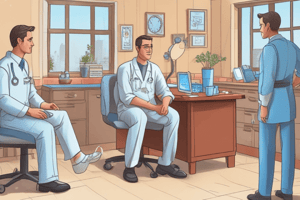Podcast
Questions and Answers
What is an essential step to perform after exploring a patient's presenting complaints?
What is an essential step to perform after exploring a patient's presenting complaints?
- Thank the patient for their time (correct)
- Summarize the patient's history
- Refer the patient to a specialist
- Prescribe medication
When should you usually summarize the information collected during a patient consultation?
When should you usually summarize the information collected during a patient consultation?
- At the end of the consultation (correct)
- At the beginning of the consultation
- Midway through the consultation
- After exploring the presenting complaint
Which of the following is necessary for effective communication with patients?
Which of the following is necessary for effective communication with patients?
- Avoid sharing treatment risks
- Listening to and respecting patient's views (correct)
- Limiting the patient's questions
- Only sharing information with close family members
What should you do if a patient makes an unusual comment or has a minor abnormality?
What should you do if a patient makes an unusual comment or has a minor abnormality?
Why might it be beneficial to let patients ask questions at the end of the consultation?
Why might it be beneficial to let patients ask questions at the end of the consultation?
What should you do to ensure a systematic collection of information from a patient?
What should you do to ensure a systematic collection of information from a patient?
Which phrase can be used to encourage a patient to continue?
Which phrase can be used to encourage a patient to continue?
What should you do if you are unsure about information provided by the patient?
What should you do if you are unsure about information provided by the patient?
How should you write down information during patient communication?
How should you write down information during patient communication?
Which phrase is useful for clarifying terms with a patient?
Which phrase is useful for clarifying terms with a patient?
What type of history information should be elicited from patients?
What type of history information should be elicited from patients?
What is advised to use when dealing with children to make them feel comfortable?
What is advised to use when dealing with children to make them feel comfortable?
What type of facial expression is recommended when talking to patients?
What type of facial expression is recommended when talking to patients?
Which is an example of an open question to start a conversation with a patient?
Which is an example of an open question to start a conversation with a patient?
Which of these actions shows that you are listening to the patient?
Which of these actions shows that you are listening to the patient?
Which prompt is appropriate to use to keep the conversation going?
Which prompt is appropriate to use to keep the conversation going?
Which disease should always be asked about in past medical history?
Which disease should always be asked about in past medical history?
Which of the following is part of past surgical history?
Which of the following is part of past surgical history?
What should be recorded under family history?
What should be recorded under family history?
What is included in social history?
What is included in social history?
Which condition is not a part of the questions for past medical history?
Which condition is not a part of the questions for past medical history?
Which of the following is NOT part of Demographic Data?
Which of the following is NOT part of Demographic Data?
What does the Chief Complaint section include?
What does the Chief Complaint section include?
What involves the system that the chief complaint is encountered within?
What involves the system that the chief complaint is encountered within?
Which of these is part of the Systemic Review?
Which of these is part of the Systemic Review?
Which main part of history would a detailed story of the condition in the patient's words fall under?
Which main part of history would a detailed story of the condition in the patient's words fall under?
Which mnemonic can be used to remember aspects of the pain symptomatology involving 'Quality', 'Intensity', and 'Site'?
Which mnemonic can be used to remember aspects of the pain symptomatology involving 'Quality', 'Intensity', and 'Site'?
Which of the following drug groups should be asked about directly for their impact on anti-coagulation?
Which of the following drug groups should be asked about directly for their impact on anti-coagulation?
What aspect of pain symptomatology does the 'O' in SOCRATES represent?
What aspect of pain symptomatology does the 'O' in SOCRATES represent?
Which of the following is NOT included in the SQITARRS mnemonic?
Which of the following is NOT included in the SQITARRS mnemonic?
Which group of drugs is commonly checked for its effect on blood glucose levels?
Which group of drugs is commonly checked for its effect on blood glucose levels?
What does the presence of bile-stained vomit indicate?
What does the presence of bile-stained vomit indicate?
Which character of vomiting is associated with gastric outlet obstruction?
Which character of vomiting is associated with gastric outlet obstruction?
What does fecal vomit suggest regarding the location of the intestinal obstruction?
What does fecal vomit suggest regarding the location of the intestinal obstruction?
What symptom is commonly associated with early morning vomiting in pregnant women?
What symptom is commonly associated with early morning vomiting in pregnant women?
Which condition could cause effortless vomiting?
Which condition could cause effortless vomiting?
What is a serious factor often associated with vomiting that includes blood?
What is a serious factor often associated with vomiting that includes blood?
Which of the following should be ensured for an optimal room environment?
Which of the following should be ensured for an optimal room environment?
What is NOT a principle for good communication with patients?
What is NOT a principle for good communication with patients?
Before starting an explanation, it is important to:
Before starting an explanation, it is important to:
Which type of question is designed to guide the patient to an answer?
Which type of question is designed to guide the patient to an answer?
When can information be retrieved from the patient's relatives?
When can information be retrieved from the patient's relatives?
What should be avoided during communication with a patient?
What should be avoided during communication with a patient?
Which of the following factors is considered in evaluating a cough?
Which of the following factors is considered in evaluating a cough?
What is orthopnea?
What is orthopnea?
Dysphagia can be described as difficulty in swallowing. Which of the following specifies painful swallowing?
Dysphagia can be described as difficulty in swallowing. Which of the following specifies painful swallowing?
A significant weight loss is defined as:
A significant weight loss is defined as:
Which symptom is characterized by shortness of breath during exertion or exercise?
Which symptom is characterized by shortness of breath during exertion or exercise?
In assessing changes in appetite, what should be determined if a decreased appetite is observed?
In assessing changes in appetite, what should be determined if a decreased appetite is observed?
What is dyspepsia commonly accompanied by?
What is dyspepsia commonly accompanied by?
What color can the skin and eyes become in non-obstructive jaundice?
What color can the skin and eyes become in non-obstructive jaundice?
Which type of stool suggests fat malabsorption?
Which type of stool suggests fat malabsorption?
What term is used to describe absolute constipation?
What term is used to describe absolute constipation?
What is the term for fresh bright bleeding per rectum?
What is the term for fresh bright bleeding per rectum?
What is the normal frequency of bowel habits?
What is the normal frequency of bowel habits?
What symptom is associated with obstructive jaundice?
What symptom is associated with obstructive jaundice?
In which condition are stools described as watery in consistency?
In which condition are stools described as watery in consistency?
Flashcards are hidden until you start studying
Study Notes
Effective Communication
- Summarize by patient's words at the end
- Explain the next step and give the patient time to digest information
- Let the patients ask questions and provide them with a source of information about their disease
- Close the interview and ask the patient if they want to tell you anything else or if anything important was missed
- It is not necessary to summarize until the end of the consultation
Communication Skills
- Listen to, ask for, and respect patients' views about their health
- Share information with patients in a way they can understand
- Include information they want or need to know about their condition, its likely progression, treatment options, risks, and uncertainties
- Answer questions and keep patients informed about the progress of their care
- Make sure patients are informed about how information is shared with other professionals involved in their care
Taking a Patient's History
- Be alert and use your senses to collect information
- Recognize an unusual comment or minor abnormality
- Demographic data: age, gender, race, marital status, residence, occupation, and religion
- Chief complaint: one or two symptoms that brought the patient to the hospital, and the duration
- History of present illness: a detailed story of the condition in the words of the patient
- Systemic review: gastrointestinal, cardiovascular, respiratory, urogenital, neurological, musculoskeletal, and integumentary systems
Vomiting
- Quantity or volume: small, moderate, or large
- Frequency: number of times
- Quality: contains previous meal, undigested recognizable food, or clear acidic fluid
- Associated blood: serious factor, either fresh or changed
- Color and taste: may assess the level of intestinal obstruction
- Character: projectile, self-induced, or effortless
- Relieve pain or not: and timing, preceding symptoms, or factors
Encouraging Patients to Continue
- Repeat the last statement made by the patient with a questioning tone
- Use phrases like "You are saying..." or "You mean that..."
Remembering Key Points
- You may receive information out of sequence
- If unsure, use phrases like "You said earlier..." or "You mentioned before..."
Writing Information Down
- Write notes in a way that doesn't interfere with communication with the patient
Clarifying Terms
- If unsure, ask the patient to explain
- Use phrases like "What do you mean by..." or "Let me understand this..."
Eliciting Information from Patients About Their Histories
- Medical, surgical, family, psychosocial, and drug histories
Conversation Tips
- Don't talk to more than one patient at a time
- Offer sweets or candies to children (remember diabetes)
- A smiley face is preferable to a frowning one
Starting the Conversation
- Introduce yourself and ask the patient an open question, such as "Can you tell me about your illness?" or "What is bothering you?"
Keeping the Conversation Going
- Use open questions to encourage the patient to give more information
- Use prompts like "How did it start?" or "What happened next?"
- Show you are listening by nodding or making brief comments
Past History
- Medical, surgical, family, social, and drug histories
Medical Symptoms Checklist
- Cough: frequency, change of posture, productive or dry, sputum color, and amount
- Dyspnea: shortness of breath, classification, and associated symptoms
- Dysphagia: difficulty in swallowing, intermittent or progressive, and painful or painless
- Weight loss: how much, period, and associated symptoms
- Appetite: increased, decreased, or remained the same, and associated symptoms
Studying That Suits You
Use AI to generate personalized quizzes and flashcards to suit your learning preferences.




